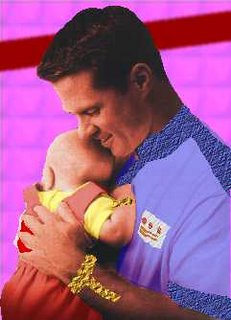The symbol of Lorecanism is the looped staff, designed after the physical staff carried by Loreca.
History
About 7900 CE, in the Credixian Imperium, the Imperator was on the outs with both the Meletian clergy and Kaalian churches. Devotees of Brandix were following a course of neutrality which began about 6000 CE.
Then came Loreca. Born Grigor Haentil of Amny, he studied at the Brandixian School on Amny until he was about 30. Then, being a student of alien philosophy, he persuaded a Galactic Rider to take him to Nephestal, where he eventually found his way into a Daamin philosophy group.
Grigor Haentil was of a Kala Phenkae branch that produced Schiller-Hertzfeld scores in the high 500s. With drugs, he was able to virtually imitate the Daamin Forever Dreams and their peculiar nonlinear causality.
In 7932 CE, when he was 56, Haentil returned to Amny. He got a lecturing post at the Brandixian School there and started on the philosophies that formed the basis of the Book of Loreca. By the time the Book was published (7943 CE), there was a growing community of Haentil's disciples on Amny and even throughout the Imperium.
In 7943 CE, at a pre-publication conference on Amny, Grigor Haentil took the pseudonym Loreca and began calling his movement Lorecanism. In part it was based on scraps of Daamin philosophy, in part on the Wakmarel disciplines, in part on pure Brandixian contrariness. But Loreca was no fool, and subsequent history has shown that he charted the right course for his movement to increase and prosper.
Mass communication played a part in the spread of Lorecanism, and the Book of Loreca became something of an undergorund bestseller. But the key to the movement was the induction of a state of awareness called kedankat, a mixture of Wakmarrel obdumat and Daamin Forever Dream, not too effective for those with low Schiller-Hertzfeld scores. The introduction of kedankat had to be done in person.
Indeed, Loreca had styled Lorecanism somewhat like a mystery religion, with kedankat in the role of the central mystery.
During his life, Loreca had two audiences with the Imperator, and in 7948 CE the Imperator gifted the movement with Credixian land and buildings that later formed the nexus of Circe Mater.
Lorecanism maintained friendly relations with the Brandixian Church, and less-than-friendly ones with the cults of Meletia and Kaal. This fact alone tied Lorecanism to the Throne, for the Imperator saw a chance to counterbalanace the power of the other Churches.
And in the course of time, Lorecanism spread through the Galaxy and became the state religion of the Second Terran Empire.
One thing is certain: Loreca himself exploited the state of kedankat until he was very nearly precognitive. It must not be forgotten that his Schiller-Hertzfeld score was very high. And it is certain that one of Loreca's close associates, perhaps even lover, was Kirl Ventag, a programmer with access to the large puters of Amny's Brandixian School.
Loreca left programs and personal writings that charted a good deal of the future of Lorecanism. All of his successors as Grand Primate, for six hundred years, were identified in enough detail that there were no succession crises to weaken the early Movement.
The Book of Loreca
The Book of Loreca is a philosophical treatise; the movement of Lorecanism was more akin to a political expansion.
One of the most beautiful passages in the Book of Loreca is the Hymn to the Rising Sun, a solo, almost a lament, to the rising sun and the indomitable principle of Light, of the driving force of Human ingenuity.
Find out more in The Leaves of October: a novel of the Scattered Worlds by Don Sakers

